Newsom Vineyards Looms Large in Texas Wines
Newsom Vineyards Looms Large in Texas Wines
by Wes MarshallSeptember 2, 2008 published on Appellation America at http://wine.appellationamerica.com/wine-review/615/Newsom-Vineyards.html#
If Texas had a Bordeaux-like list of first growth vineyards, Neal Newsom’s Texas High Plains appellation property would be listed as Superior First Growth. He sells to dozens of wineries all over the state, most of which make the grapes into uniformly superior wines (see tasting notes below).
Newsom is also active in helping the state’s farmers and winemakers create better wines and be more profitable. He is the current President of the Texas Wine and Grape Growers Association, a very active and influential trade group. He’s also the sponsor of the annual Newsom Grape Day, an opportunity for growers to learn the latest ways to improve their crops from some of the best scientific minds in the industry as well as a chance to see masses of new farm equipment in one place.
A lanky Texan, Newsom is prone to drawling and understatement. He’s also slow to make pronouncements, so when one pops out, you pay attention. More than a few popped out in my recent interview with him.
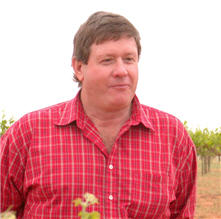 Neal Newsom heads Newsom Vineyards and the Texas Wine and Grape Growers Association.
Neal Newsom heads Newsom Vineyards and the Texas Wine and Grape Growers Association.
Appellation America: Your vineyard is here in the middle of huge parcels of cotton and soybeans. How did you choose grapes?
NN: I went to Texas Tech and had a professor, Dr. Roy Mitchell, who used to compare the Lubbock area to wine areas of the world. I came home to a cotton farm, but I was always into alternative crops like alfalfa and peanuts, so I decided to give grapes a try.
AA: When was that?
NN: My first planting was in 1986 and there were only four wineries back then. We started off with just three acres of Cabernet. At the time, I knew we’d have to hand harvest, so I wanted a low yielder. It was also worth a little more, so I thought it might work well.
AA: Did you plan on keeping it small, or did you have bigger dreams?
NN: Well, let’s just say that I designed the vineyards to be able to use machine harvesting because I was pretty sure that there would be a machine out here someday.
AA: How fast did you expand?
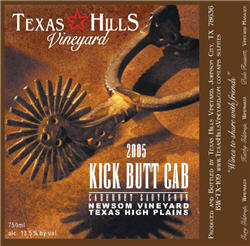 NN: The next year we planted two more acres and we would just keep planting a couple of acres each year. When we got up to 18 acres, we had to stop because we were running up against a wall trying
NN: The next year we planted two more acres and we would just keep planting a couple of acres each year. When we got up to 18 acres, we had to stop because we were running up against a wall trying
Texas Hills Winery’s Kick Butt Cabernet is just one of the many wines that are produced from Newsom Vineyards grapes. Labels from other wineries’ Newsom Vineyard wines appear below.to do hand harvesting. A few years later, one of the wineries bought a mechanical harvester and they would do custom work for their growers and once we saw how easy that was, we started planting again. We would add about 5 acres per year until we got up to where we are now, 92 acres.
AA: There weren’t a lot of other growers at the time, so the knowledge bank was pretty thin. How did you decide what to grow?
NN: I am an avid armchair researcher so I hit the books the best I could. If I got interested in a grape that was in the area, I picked the brains of the growers. If no one had it, I tried to pick grapes that would work in our climate.
AA: So did you just plant them and hope to sell them?
NN: Of course, I had to be able to sell the grapes, so I would have to have a buyer before I ever planted it. Usually, I got a request from a winery to try the varietal. If it was a grape we didn’t know about, one that hadn’t been around here, I would ask them to participate in the cost.
AA: Shrewd business move.
NN: That was one of the big problems we had on the High Plains. When everyone came out here in the beginning, they wanted to grow everything under the sun, especially the popular grapes. But we just can’t grow Chardonnay out here. It doesn’t work. Neither does Pinot Noir. We get a decent yield but the quality isn’t what it needs to be. Zinfandel can be grown here, but it gets so many diseases it’s really tough.
AA: So what have you found does work on the High Plains?
NN: My two favorite varieties are Tempranillo and Malbec. We get good yields and the fruit is really powerful. Another grape that’s growing well for us is Pinot Grigio.
AA: You’re not mentioning the grape you are best known for.
NN: Yeah. It’s true we’re known out here for our Cabernet, but it’s the hardest grape of all the ones I grow. It’s not a high producer, in fact, the yields are really low. The winemakers love it because with the low yields, we get good quality. We’re also famous for our Orange Muscat, but it’s like the Cabernet. It’s real finicky and we get low yields.
AA: Of course, that’s the constant issue between the grape grower and the winemaker. A farmer has to put in the work and he wants more grapes to sell, while the winemaker wants stressed, low yielding grapes for their intensity.
NN: We have good relationships with our winemakers and we usually get all that worked out in advance.
AA: I know a lot of winemakers have been winning awards with your grapes. Tell us some.
NN: Are you trying to get me in trouble? You know I’m gonna miss some and they’ll be on the phone saying, “Hey Neal, what about me?”
AA: I know there’s been a lot, but just mention a few.
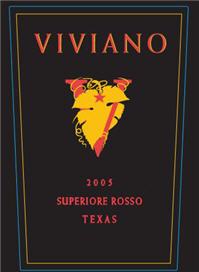 NN: OK. Here’s a few off the top of my head. Llano Estacado won for our Cab and Merlot, plus their best wine, Viviano uses our Sangiovese. Becker’s Cab Reserve has won several. Fredericksburg Winery was the first to win for our Orange Muscat. Texas Hills has won a lot for its Kick Butt Cab. LightCatcher has won several medals with my Merlot and they’ve done well with their Dry Muscat. Sunset Winery has gotten a few medals for our Cab and Malbec. Barking Rocks won with our Sangiovese. Gosh, Wes, there’s so many.
NN: OK. Here’s a few off the top of my head. Llano Estacado won for our Cab and Merlot, plus their best wine, Viviano uses our Sangiovese. Becker’s Cab Reserve has won several. Fredericksburg Winery was the first to win for our Orange Muscat. Texas Hills has won a lot for its Kick Butt Cab. LightCatcher has won several medals with my Merlot and they’ve done well with their Dry Muscat. Sunset Winery has gotten a few medals for our Cab and Malbec. Barking Rocks won with our Sangiovese. Gosh, Wes, there’s so many.
AA: OK, that’s enough. I know you like to experiment. What other grapes have you been looking at?
NN: I think we have a great opportunity to grow good quality Albariño. I’d love to see a distillery open because we could grow really good Trebbiano for brandy. I’m also going to take a shot at Syrah. There’s been a lot of failed Syrah around here, but I’ve got a rootstock/clone combination that is working pretty well on an experimental row.
AA: You keep up with everyone in the High Plains. What grapes are producing the best wines right now?
NN: Of course everyone does well with Cabernet Sauvignon and Merlot. Cabernet Franc, Tempranillo and Malbec are 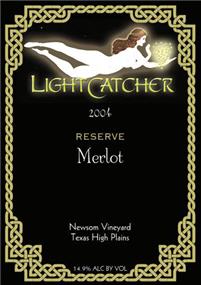 doing well, too. Dolcetto is a dry wine, but the High Plains version has the sweetest fruit. In the whites, Viognier, Pinot Grigio and Vermentino are working real well. I’m also hearing that Marsanne and Roussanne are doing well, but I haven’t tried any yet.
doing well, too. Dolcetto is a dry wine, but the High Plains version has the sweetest fruit. In the whites, Viognier, Pinot Grigio and Vermentino are working real well. I’m also hearing that Marsanne and Roussanne are doing well, but I haven’t tried any yet.
AA: What’s the hottest varietal in the High Plains right now?
NN: Oh, that would be Viognier. Lots of folks are planting it.
AA: If you had the opportunity to predict five or ten years from now, what do you think your appellation will be best known for?
NN: Probably Cab will always be king around here. After that? Let’s see. Ten years from now? Viognier, Tempranillo, and Malbec, in that order.
AA: Anything standing in your way?
NN: Well, late frost and hail are always problems. But other than that, we have two problems. Our biggest issue is the guest worker program. If we can’t get labor, we’ll all be out of business. We have to have a friendly guest worker program. If it’s a bureaucratic nightmare, it won’t get used. We’re asking folks to do hard, monotonous work that no one in our area seems to want to do. We’ve got to have the guest workers or we’re out of 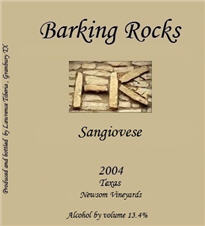 business. I refuse to use illegal immigrants, but if the program isn’t friendly, that’s all that will be available, and for me, since I won’t use illegals, then me and a lot of other farmers will be in trouble.
business. I refuse to use illegal immigrants, but if the program isn’t friendly, that’s all that will be available, and for me, since I won’t use illegals, then me and a lot of other farmers will be in trouble.
We’ve got another giant issue coming down the road in a few years. The big seed companies are getting ready to release these genetically modified row crop seeds (like cotton and soybean) that are immune to 2-4-D herbicide. That means these huge commercial farms will be using 2-4-D to clean their fields and any that drifts on us will kill our vines immediately. And that’s not the worst. 2-4-D can volatilize for up to three days and move in the wind, so even if they spray it on a quiet day, it can still spread and kill our vines.
Most of the farmers care, but if everyone starts using these seeds and 2-4-D, then pretty soon you are in a mono-culture where everyone is using the herbicides and then all our vines will be killed.
AA: What’s the solution?
NN: We don’t know yet. But we are trying to get a head start on the problem.
AA: That’s potentially devastating. I wish you luck. Hopefully someone in the government will do something to protect our grape business. On a lighter note, what do you drink at home?
NN: You’re trying to get me in trouble again. I drink mostly reds, Cabernets. I try all the Texas wines I can. It always amazes me how you can take the same grape grown by the same person and send it to several different wineries and they all come out different. And the best wines aren’t always from the big guys. You know, there’s only one best way to make wines, but that changes with every vintage and anyone might hit the jackpot.
AA: Any wisdom to pass along to youngsters in your business?
NN: Yeah. Start small and make sure you sell your grapes before you start. Make your mistakes while you’re small so that you’ll know what you want to do when you get big.
Tasting Notes for Wines Made From Neal Newsom’s Grapes
The Texas High Plain Wines
Bar Z Wines 2004 Sangiovese $20
Barking Rocks Winery 2004 Sangiovese $20
Becker Vineyards 2005 Cabernet Reserve $25
Inwood Estates Vineyards 2004 Tempranillo-Cabernet $40
Inwood Estates Vineyards 2005 Cornelious Tempranillo $40
Lightcatcher Winery 2004 Cabernet $30
Lightcatcher Winery Reserve Merlot $32
Llano Estacado Winery 2005 Viviano (Cabernet and Sangiovese) $40
Los Pinos Ranch Vineyards 2004 Sangiovese $20
Sunset Winery 2004 “Sun Ray” Cabernet $20
Sunset Winery 2004 Vintner’s Reserve Barrel Select Blend (Malbec, Cab, Merlot) $35
Sunset Winery 2004 Twilight Tango Malbec $25
Texas Hills Vineyard 2005 “Kick Butt” Cabernet $25
Texas Hills Vineyard Orange Moscato $18
I’ve had so many great bottles of wine made from Neal Newsom’s grapes that I started to wonder if anyone was making middling to bad wines from his grapes.
Three Takes on Newsom Vineyards’ Sangiovese
I tasted three Sangiovese wines, two from the 2004 vintage and one for 2005. A few traits went across the wines: First, the color is the proper deep red. No Alicante wannabes here. Second, these are very limited release wines. Finally, all had a slight amaro kick at the finish. Monty Dixon’s Bar Z winery makes such a small amount of wine, it’s almost as if he wants to make sure he could drink all of it himself if he couldn’t sell it. Which is probably a concern since he lives in an area of the Panhandle bereft of wineries or wine drinkers. His Sangiovese is rich, chocolaty and dense, with lots of tobacco and a very long finish. Taking a tip from Sting and Seal and The Artist Formerly Known as Prince, the owner of Barking Rocks Winery goes by a single name: Tiberia. He makes about 600 cases of wine a year, including a wine made from Newsom’s Sangiovese. His Italian family has always made wine and that knowledge bank speaks loud and clear in this wine, which is lighter looking but very fruity with plum aromas dominating. Jeff Sneed is a recent transplant to Texas. He was an architect working in Los Angeles and sort of randomly picked the little east Texas town of Pittsburgh to open his Los Pinos Ranch Vineyards. His version of the Newsom Sangiovese has vivid raspberry and cinnamon aromas with a silky mouthfeel.
Five Cabernet Sauvignon made from Newsom Vineyards’ Grapes
This is the money grape for the High Plains appellation and it’s also where Neal Newsom made his reputation. Along with his Muscat, Neal’s Cabernet seems immune to winemaking mistakes. Still, all these wines taste completely different. Two wines from the 2004 vintage are current releases. Caris Palm Turpin makes Lightcatcher’s wines and, despite not having decades of experience, most winemakers around the state would rank her as one of our best. Her Newsom Vineyards Cabernet has big tannins, dark color, a hint of cinnamon and a very long finish. This wine is still a baby and should get better for several years. Sunset Winery’s “Sun Ray” Cabernet has much softer tannins in a friendly, ready to drink style. The wine is smooth and made for casual drinking. 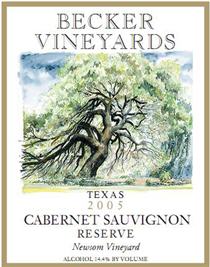 Gary Gilstrap was a pharmacist and he is an activist winemaker, comfortable with micro-oxygenation, barrel alternatives and anything else he needs to use to make the best wine he can. His 2005 Texas Hills Kick Butt Cab has tongue tickling acidity with sarsaparilla and cola on the nose. His version has very soft tannins and is ready to drink right now. Many consumers would pick Becker Vineyards as the best winery in the state, and while there are several other wineries that could just as easily take that title, there’s no arguing with the consistent excellence of winemaker Russell Smith’s skill. The Becker Cab Reserve has gorgeous color, big fruit that’s perfect balanced with the acids and a long finish of sweet fruit and leather. The wine has the elegance of Bordeaux with a dollop of California fruitiness. If it said Napa on the label it would cost $125. Another winery frequently mentioned at or near the top is Llano Estacado. Winemaker Greg Bruni spent his youth in California making wine all over the state. He has been at Llano for 15 years, learning the specifics of working with Texas fruit. A few years ago, he decided to create a tête de cuvée. It’s called Viviano and it is consistently one of the best red wines in Texas. Greg’s tastes run more to the Old World than the New, and he’s aiming at a super Tuscan style, blending Newsom’s Cabernet and Sangiovese. The 2005 is a gorgeous deep color with plum and red berry aromas and plenty of grip. It’s still a baby. This ideal wine for a grilled steak.
Gary Gilstrap was a pharmacist and he is an activist winemaker, comfortable with micro-oxygenation, barrel alternatives and anything else he needs to use to make the best wine he can. His 2005 Texas Hills Kick Butt Cab has tongue tickling acidity with sarsaparilla and cola on the nose. His version has very soft tannins and is ready to drink right now. Many consumers would pick Becker Vineyards as the best winery in the state, and while there are several other wineries that could just as easily take that title, there’s no arguing with the consistent excellence of winemaker Russell Smith’s skill. The Becker Cab Reserve has gorgeous color, big fruit that’s perfect balanced with the acids and a long finish of sweet fruit and leather. The wine has the elegance of Bordeaux with a dollop of California fruitiness. If it said Napa on the label it would cost $125. Another winery frequently mentioned at or near the top is Llano Estacado. Winemaker Greg Bruni spent his youth in California making wine all over the state. He has been at Llano for 15 years, learning the specifics of working with Texas fruit. A few years ago, he decided to create a tête de cuvée. It’s called Viviano and it is consistently one of the best red wines in Texas. Greg’s tastes run more to the Old World than the New, and he’s aiming at a super Tuscan style, blending Newsom’s Cabernet and Sangiovese. The 2005 is a gorgeous deep color with plum and red berry aromas and plenty of grip. It’s still a baby. This ideal wine for a grilled steak.
Merlot
Lightcatcher has had a great run of wines with Newsom’s Merlot. The current 2004 Lightcatcher Reserve has a huge hit of alcohol (14.9%) but none of the 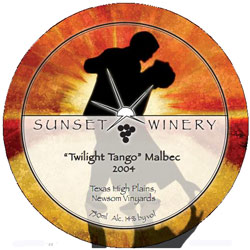 heat you might expect. The nose has a lovely perfume with just a touch of cola, caramel and black pepper. The mouthfeel is velvety but has good grip, sweet fruits and a l-o-n-g finish. I couldn’t detect the alcohol at all.
heat you might expect. The nose has a lovely perfume with just a touch of cola, caramel and black pepper. The mouthfeel is velvety but has good grip, sweet fruits and a l-o-n-g finish. I couldn’t detect the alcohol at all.
Malbec
Bruce and Birgit Anderson got on the Newsom Malbec bandwagon early and they make two excellent wines. They describe the 2004 Sunset Winery Vintner’s Reserve Barrel Select Blend as their best wine. It’s a combination of Cabernet, Malbec and Merlot. The Malbec dominates with smoky chocolate aromas, soft tannins, a smooth mouthfeel and good balance. Their Sunset Winery Twilight Tango Malbec is fully competitive with most Argentine wines. It has soft but abundant tannins, smoked plum aromas, and a long finish with cleansing acidity. Grilled lamb chops, oh boy!! They only make 120 cases.
Tempranillo
Dan Gatlin’s Inwood Estates Vineyards makes pure magic with Newsom’s Tempranillo. He is obsessed with making great wine and over the 25 years he’s been perfecting his skills, he has poured out more than he’s sold to make sure nothing but his best efforts ever get out of the winery. After planting and pulling vineyards all over the state, he finally settled on a partnership with Neal Newsom. He cites the cool nights as the reason he favors the High Plains. Both his Tempranillo Cabernet Blend and his straight Tempranillo, “Cornelious,” rank among Texas’s finest wines. Gatlin is so secure in the quality that he travels with bottles of Clos de l’Obac Priorat or one of the Muga Riojas to let people do a taste off. He wins.
Orange Muscat
Newsom’s vineyard has suffered from hail for the last three years, especially his Muscat, so he hasn’t had much to sell. Two wineries that always do a good job with it are Flat Creek, with a Spätlese style, and Lightcatcher with a fascinating, bone-dry version. Unfortunately, neither have any Newsom fruit currently. Texas Hills managed to get enough to make a 2005 vintage. Its gorgeous floral and orange peel aromas will have you swirling your glass endlessly. The sweetness is balanced with enough acid to make the wine food friendly with Asian foods. The long lasting finish keeps the retro-nasal floral aromas swirling around your palate right to the end. Back to top
Pho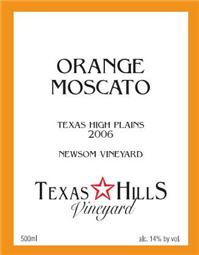 tos by Wes Marshall
tos by Wes Marshall READER FEEDBACK: To post your comments on this story, click here
READER FEEDBACK: To post your comments on this story, click here
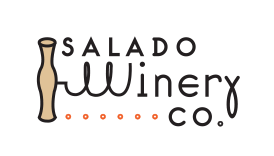
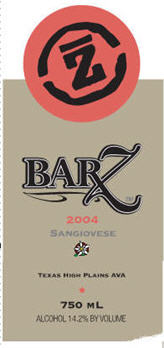
Trackbacks & Pingbacks
[…] newsom vineyards looms large in texas wines […]
Comments are closed.